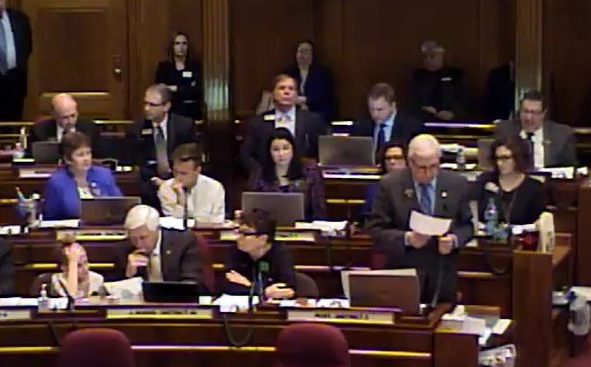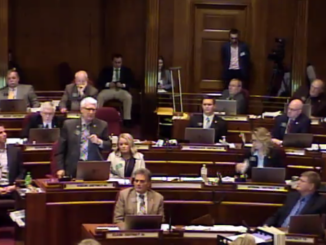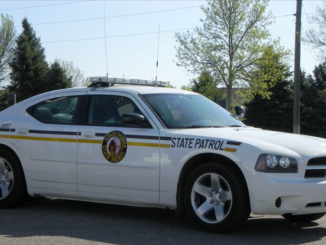
Last Monday, we published an article explaining how four Republicans had sponsored legislation that sought to ban minors from riding in the beds of pickup trucks. It was Senate Bill 2129. At the time of writing that article, the bill had come out of the Senate Transportation Committee with a 5-1 Do Not Pass recommendation and was set to hit the Senate floor later that day. Unfortunately, as is often the case, the week got away from me and I haven’t had the opportunity to update you on the outcome of the bill. Well, it failed. But for all the wrong reasons.
As you can see here, SB 2129 was killed by a vote of 1-45. So far everything sounds great, right? Well, the vote totals aren’t quite as encouraging as they appear to be. From the looks of it, you would think that the Senate had suddenly found their limited government roots. But I assure you that they haven’t.
I’ll admit that when I saw the 5-1 Do Not Pass out of committee, I was surprised. But after seeing Senator David Rust (R – District 2) — who is also Chairman of the Transportation Committee — explain why they made their recommendation, I wasn’t quite as encouraged anymore.
I suggest that you watch Senator Rust’s remarks. In a nutshell, he explained that the committee decided the bill wasn’t needed, because they were led to believe that current law already forbids the practice of minors riding in the beds of pickup trucks. How did they come to this conclusion? Well, according to Senator Rust, it was with the help of the North Dakota Highway Patrol.
In his remarks as bill carrier, Senator Rust cited current North Dakota Century Code Section 39-21-41.2 as the premise for asking that the bill be killed. Let’s take a look at this law:
“If a child, under eight years of age, is present in a motor vehicle, that motor vehicle must be equipped with at least one child restraint system for the child. However, a child under the age of eight who is at least fifty-seven inches [1.45 meters] tall is not required to use a child restraint system, but must be correctly buckled in a safety belt. The child restraint system must meet the standards adopted by the United States department of transportation for those systems [49 CFR 571.213]. While the motor vehicle is in motion, the child must be properly secured in the child restraint system in accordance with the manufacturer’s instructions. While the motor vehicle is moving, each child of eight through seventeen years of age who is in the motor vehicle must be in an approved child restraint system in accordance with the manufacturer’s instructions or correctly buckled in a safety belt. Use of child restraint systems and safety belts is not required in motor vehicles that were not equipped with safety belts when manufactured. If a child is being transported in an emergency situation, this section does not apply.” (Emphasis Added)
As you can clearly see, at least three very important points are evident from the law:
- The child must be “in” the motor vehicle.
- “… the child must be properly secured in a child restraint system in accordance with the manufacturer’s instructions or correctly buckled in a safety belt.”
- “Use of child restraint systems and safety belts is not required in motor vehicles that were not equipped with safety belts when manufactured.”
With these key points in mind, let’s consider these important questions in relation to each one:
- Is the bed of a pickup truck “in” a motor vehicle? I’d suggest that it’s not. But even this question isn’t the strongest argument when we consider points #2 and #3.
- Can the entirety of the statute be interpreted simply by looking at the requirement that, “… the child must be properly secured in a child restraint system in accordance with the manufacturer’s instructions or correctly buckled in a safety belt”? I’d suggest an emphatic, “NO!” We must look at the law in its entirety. Which leads me to #3.
- Could the law be any clearer? Just to reiterate what the law says, “Use of child restraint systems and safety belts is not required in motor vehicles that were not equipped with safety belts when manufactured.” Again, we have this word “in”. But let’s suppose for a moment that “in” also means the beds of pickup trucks. The law is crystal clear— if the motor vehicle wasn’t equipped with safety belts, then those belts are not required. And it’s obvious, the beds of pickup trucks do not have safety belts. Therefore, they cannot be required.
Consider this too— Don’t you suppose that might just be the reason the law hasn’t been interpreted in the way the Transportation Committee now sees it?
People have allowed their kids to ride in the beds of pickup trucks for decades. For many of us, it was almost a rite of passage growing up. I don’t know how, but the Senate Transportation Committee allowed themselves to be convinced by the North Dakota Highway Patrol that current law already prohibits the practice— when in fact, it doesn’t. How anyone could read this law and believe such a thing is baffling to me.
But hey, I hoped for the bill to be killed and it was. We’ve got that going for us. Only now, I fear that law enforcement across North Dakota will begin trying to enforce current law for something it simply doesn’t apply to. In fact, such an interpretation would be even more restrictive than what SB 2129 was proposing. At least it had an exception for parades.
As a result, adults across the state may now find themselves in the unenvious position of having to defend against the misapplication of current law. I think that may be even more ridiculous than SB 2129 was in the first place.
PLEASE LIKE & SHARE!
Sources:
- https://theminutemanblog.com/2019/01/21/four-republicans-seek-to-end-minors-riding-in-truck-beds/?fbclid=IwAR3Q0N6AQgrN_11JM0QhHb2-vEUjE08T7alV2vZBBY_f3SfeenSO3ki9HyQ
- https://www.legis.nd.gov/assembly/66-2019/bill-index/bi2129.html
- https://www.legis.nd.gov/assembly/66-2019/bill-actions/ba2129.html
- http://video.legis.nd.gov/en/PowerBrowser/PowerBrowserV2/20190127/-1/10053?startposition=20190121131439





